
Aberford is a village and civil parish on the eastern outskirts of the City of Leeds in West Yorkshire, England. It had a population of 1,059 at the 2001 census, increasing to 1,180 at the 2011 Census. It is situated 10 miles (15.5 km) east, north east of Leeds and west of the A1(M) motorway.
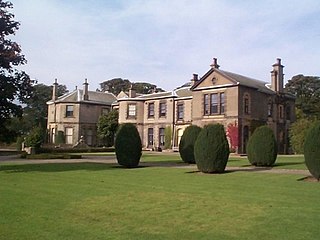
Lotherton Hall is a country house near Aberford in West Yorkshire, England. It is a short distance from the A1(M) motorway, 200 miles (320 km) equidistant from London and Edinburgh. It is one of nine sites in the Leeds Museums & Galleries group.

Barwick-in-Elmet is a village in West Yorkshire, 7 miles (11 km) east of Leeds city centre. It is one of only three places in the area to be explicitly associated with the ancient Romano-British kingdom of Elmet, the others being Scholes-in-Elmet and Sherburn-in-Elmet.

Scholes-in-Elmet is a village in Leeds, West Yorkshire, England. Its name is a plural of Old Norse skáli meaning "temporary shed".
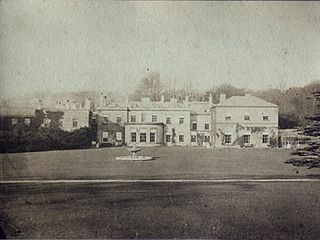
Parlington Hall was the seat of the Gascoigne family, Aberford near Leeds in West Yorkshire, England.

The Gascoigne Baronetcy, of Barnbow and Parlington in the County of York, was a title in the Baronetage of Nova Scotia. It was created on 8 June 1635 for John Gascoigne. He had converted to Roman Catholicism in 1604. His daughter, Catherine Gascoigne, went to Cambrai where she became an abbess. Gascoigne's son Sir Thomas, 2nd Baronet, was accused of conspiracy to murder King Charles II as part of the mythical Popish Plot, but acquitted. The eighth Baronet was Member of Parliament for Thirsk, Malton and Arundel. He renounced Catholicism, and was much involved in the Irish Parliament and in horse racing. Sir Thomas died in 1810, the year after his only son died in a hunting accident, upon which the baronetcy became either extinct or dormant.
Tadcaster Rural District was a rural district in the West Riding of Yorkshire from 1894 to 1974. It was named after Tadcaster.
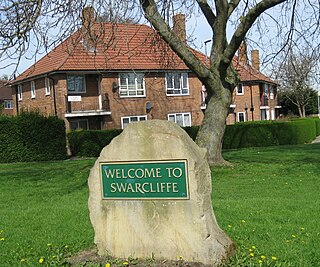
Swarcliffe, originally the Swarcliffe Estate, is a district of Leeds, West Yorkshire, England. It is 4.9 miles (8 km) east of Leeds city centre, and within the LS14 and LS15 Leeds postcode area. The district falls within the Cross Gates and Whinmoor ward of the Leeds Metropolitan Council.

Brown Moor is an area in the metropolitan borough of the City of Leeds in West Yorkshire, England, east of Austhorpe and north of Colton. The M1 motorway and the A63 road pass it on its eastern flank and the A6120 road in the south. The area is named after a nearby hill. A colliery operated here in the 19th century and was accessed by a spur off the Leeds and Selby Railway, but was already disused in the early 20th century. At that time, some cottages had been erected nearby. Those had been sold by 2002 when Thorpe Park was established in the area.

Thomas Gascoigne was a Yorkshire land and coal-owner.

Sir Thomas Gascoigne, 8th Baronet was born on 7 March 1745 on the Continent into a devout Catholic gentry family based in Yorkshire. Despite receiving a solid Catholic education at institutions in northern France and Italy, Gascoigne would later renounce his religion to become a Foxite Whig Member of Parliament. Prior to his apostasy, he travelled extensively as a Grand Tourist throughout much of Spain, France and Italy in the company of the noted travel writer Henry Swinburne, who would later record their journeys in two popular travel guides Travels through Spain in the Years 1775 and 1776 (1779) and Travels in the Two Sicilies, 1777–1780 (1783–5). Together they gained close access to the leading courts of Europe, particularly in Spain and Naples. An honorary member of the Board of Agriculture, Gascoigne was an important advocate of agricultural reform as well as a considerable coal owner who helped pioneer technological developments in the extractive industries. He is emblematic of how movements within the Enlightenment were having a major influence on the attitudes, activities and outlook of many leading English Catholic gentry families in the period.
The Aberford Railway was a privately owned light railway built in the 19th century between Garforth and Aberford in West Yorkshire, England. It was owned by the Gascoigne family of Yorkshire to transport coal from their collieries via the Great North Road and a connection with the Leeds and Selby Railway. The railway was locally known as the Fly Line.

Lotherton cum Aberford is a civil parish in the metropolitan borough of Leeds in West Yorkshire, England. The population of the civil parish at the 2011 Census was 323. Until 1974 it was in the Tadcaster Rural District in the West Riding of Yorkshire.
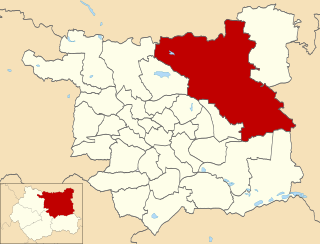
Harewood is an electoral ward of Leeds City Council in north east Leeds, West Yorkshire, covering rural villages including Barwick-in-Elmet, Collingham, Harewood, Scholes and Shadwell.
Richard Philip Oliver, later known as Richard Oliver Gascoigne, was an Irish landowner at Castle Oliver in County Limerick and Parlington Hall in Yorkshire.
Colonel Frederick Richard Thomas Trench-Gascoigne DSO JP was a British soldier and landowner.
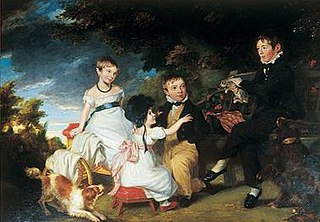
Elizabeth Gascoigne was the heiress to the Gascoigne estate, eventually becoming the main owner of Lotherton Hall in Leeds which is now owned by Leeds City Council as part of the Leeds Museums and Galleries. She was a woman of many talents, dabbling in writing books, designing stained glass windows, playing the harp and being a charitable contributor to the community of Leeds, mainly Aberford in Yorkshire and Ashtown in Ireland. Her works in stained glass have been displayed in exhibitions, and many of the buildings her and her sister commissioned are still part of the communities that they lived in.
Laura Gwendolen Douglas Galton Gascoigne CBE DStJ, was a British nurse, writer, and singer.
Aberford and Lotherton cum Aberford are adjacent civil parishes in the metropolitan borough of the City of Leeds, West Yorkshire, England. The parishes contain 25 listed buildings that are recorded in the National Heritage List for England. Of these, one is listed at Grade II*, the middle of the three grades, and the others are at Grade II, the lowest grade. The parishes contain the village of Aberford and the surrounding countryside, including the area around Lotherton Hall. Most of the listed buildings are houses and cottages, and the others include churches, a market cross, a former water mill and a former windmill, a bridge, farm buildings, a hotel and a former stable block, a war memorial, and three milestones.













